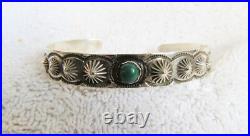
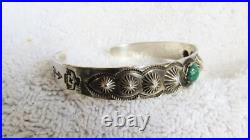

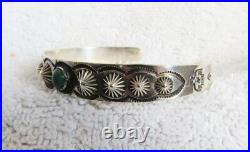
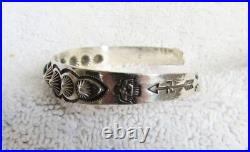
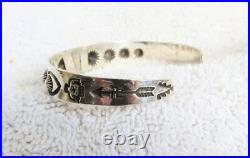



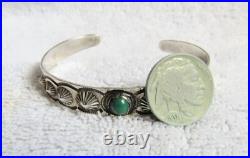

Being offered is a rare, vintage, antique, Navajo Indian made jewelry bracelet. The bracelet is crafted from sterling silver with a rare green Cerrillos turquoise stone setting. The bracelet is from the Fred Harvey era, with the classic die stamped designs including an an arrow with whirling logs, a thunderbird, and other symbols. The bracelet does show typical age related wearing. The bracelet has had a professional repair a long time ago as it shows wearing. Apparently the bracelet broke, and was repaired with a sterling silver buttress piece which strengthened the weak portion. The repair is well done and shown in the pics. These bracelets did break in the middle portions when people tried to squeeze or pull the bracelet apart to make it bigger or smaller, applying undo pressure on the middle portion. The inside diameter is approx. 6 including the back opening, and the back opening is approx. The bracelet is approx. 3/8 wide at its widest portion. The bracelet weighs approx. The Fred Harvey Era was during the start of the early tourist travel to the southwest. This started the demand for Native American Indian jewelry in the tourist trade. Fred Harvey set up hotels and motels along cities and train depots to service the travelers. Natives Indians set-up stands and tables to sell their wares to travelers or those just having a rest stop while on the train. Later, roads like Route 66 became the main travel route for vacationers, so tourist shops and trading posts sprung up all along the Mother Road (Route 66). Fred Harvey jewelry was always unsigned except for an occasional piece and is the most collected Indian jewelry today. The designs and styles are unmistakable for Fred Harvey era jewelry. The earliest known swastika was seen about 10,000 years ago. The intricate pattern of joined swastikas was found on a late paleolithic figurine of a bird, carved from mammoth ivory, found in Mezine, Ukraine. The word’swastika’ derives from an Asian Indian Sanskrit word, in which the meaning of the swastika stands for universal welfare. “Swasti” means well-being of one and all and “ka” means symbol. The swastika is one of the most ancient of all symbols and used as a symbol for peace, life and good luck. In the Western world, it was a symbol of auspiciousness and good luck until the 1930s, when it was hijacked by the German Aryan party. I find the taking of an Indian symbol despicable, and chose not to mention their name. The swastika motif is found in some traditional Native American art and iconography. Historically, the design has been found in excavations of Mississippian-era sites in the Ohio and Mississippi River valleys. It is also widely used by a number of southwestern tribes, most notably the Navajo, and plains nations such as the Dakota. The Aryan icon is an inverted version of the traditional American Indian symbol, which usually features the arms pointing counterclockwise. Before the 1930s, the symbol for the 45th Infantry Division of the United States Army was a red diamond with a yellow swastika, a tribute to the large Native American population in the southwestern United States. It was later replaced with a thunderbird symbol. The swastika is a Navajo symbol for good luck, also translated to whirling log. The symbol was used on state road signs in Arizona. In the late 19th and early 20th centuries, the swastika symbol became established in Western cultures, especially with the Navajo culture, as a good luck or good fortune symbol, and was used in Native healing ceremonies. The Navajos incorporated the swastika into their rugs, jewelry, and art. Arizona’s indigenous Pima and Maricopa people wove them into their baskets and painted them onto their pots. The swastika’s meaning does seem to be similar across cultures, generally denoting abundance and prosperity and referring to the four cardinal directions. In addition, I sell items for Native Americans and from personal collections. Please feel free to contact me with any questions about my items. Please let me know ahead of time. I will try my best to get the item out sooner. Thanks for your business.
